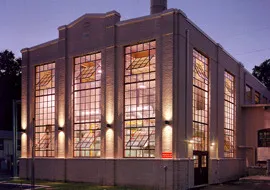Energy

The conservation of resources is the heart of any sustainability plan. Energy resources represent a significant part of the heat plant budget and the bulk of the College's carbon contribution to the atmosphere. Better than 99% of the Colleges' energy comes through the Heat Plant which is found on the southwestern side of the campus. Learn more about how we manage energy.
The Heat Plant boilers provide steam to many of the major buildings on campus and a number of the smaller buildings. Although we have the ability to burn #2-0.02% sulfur oil or natural gas we choose to burn natural gas as it is significantly cleaner burning. We hold the fuel oil in reserve in the event that our natural gas supply is interrupted. We average about a 1,000,000 therms of fuel in a year which in real terms represents one hundred million cubic feet of natural gas or an equivalent of 660,000 gallons of fuel oil.
Electricity comes into the campus on a 33kVa line and is stepped down to 4,160V for distribution through the Campus. A series of smaller transformers step down the voltage to usable levels in each building. We average about 13,500,000 kilowatt-hours (kWh) per year. A large home probably uses less than 30,000 kWh so you could say the college uses enough electricity to power a small community of five hundred homes. Swarthmore College has purchased Renewable Energy Credits (REC's) in the form of wind power since 1999. We have gradually increased that commitment and in 2013 signed a contract to achieve 100% REC's to offset our greenhouse gas emissions from electricity use. We have also partnered with the Borough of Swarthmore to be recognized as a Green Power Community and are listed as a leader in the Green Power Partnership sponsored by the EPA.
Pennsylvania was one of the first states to de-regulate the electric and gas utilities. This has had important benefits to end users who can now select from a number of providers for electric power and natural gas. Large users can also participate in Demand Response programs sponsored by our Regional Transmission Organization (RTO) PJM. PJM operates the electric grid covering a large part of thirteen states and the District of Columbia. In a nutshell, Demand Response is a program wherein end users limit their electric use when PJM calls for a reduction during high demand periods. The ability to call for a reduction rather than firing up another generator limits the strain on the transmission lines and transformers, reduces the risk of a black out from failed equipment and minimizes emissions from generators. The College has partnered with various providers in the Demand Response program since 2009. Limiting demand is one of the foundation blocks of our energy management program. We also participate in the Smart Incentives program offered by our Local Distribution Company PECO which offers rebates for certain energy conserving equipment and lighting retrofits.
It is gratifying to see that even with the growth of the campus we have managed to not only hold the line on energy, but actually reduce our use. We do this through an aggressive energy management program and a sophisticated Siemens building management system.



